As more and more people learn about the fantastic health benefits of including mushrooms in their diets, a broader range of edible gourmet mushrooms are gaining popularity.
One of these gourmet species is the chestnut mushroom (Pholiota adiposa) that has been eaten and enjoyed for centuries in Japan but is still relatively unknown in the western world.
The chestnut mushrooms’ beautiful colors, mild flavor and wonderful texture are proving popular, and growers are now cultivating them in Japan, Asia, Europe, Australia and North America.
In this article, you’ll discover what chestnut mushrooms are, their taste, where they grow, how to grow your own and how to prepare and cook them with delicious recipes.
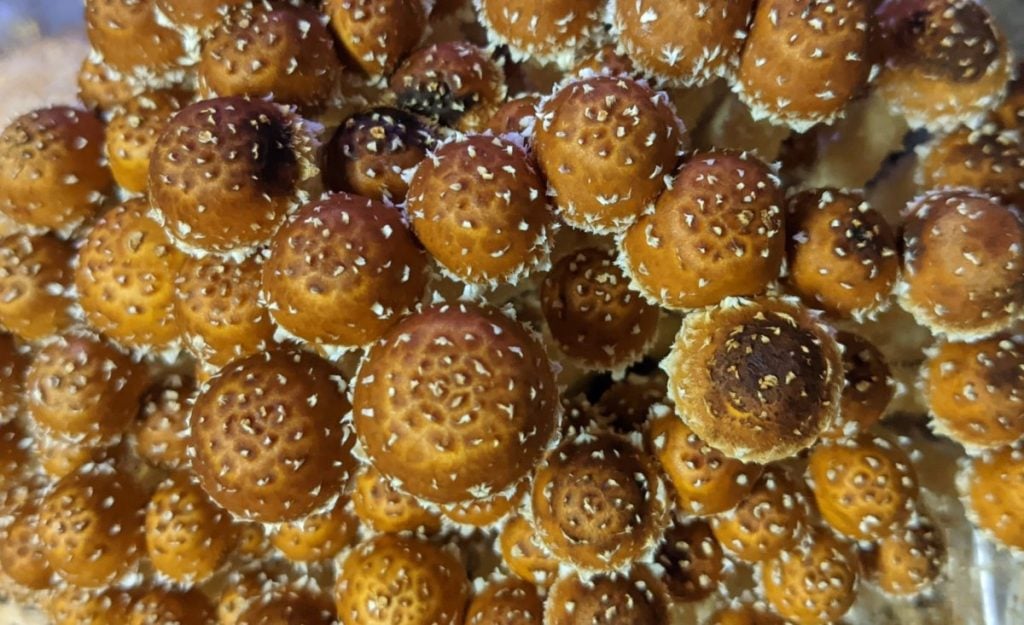
What Are Chestnut Mushrooms?
Chestnut mushrooms (Pholiota adiposa), also called cinnamon caps and fat Pholiota, are known as numerisugitake mushrooms in Japan.
They’re saprotrophic, sometimes parasitic mushrooms that, in the wild, grow in dense clusters on rotting wood.
These mushrooms are not to be confused with a darker version of the common brown, button or cremini mushrooms (Agaricus bisporus), sometimes marketed as chestnut mushrooms because of their shape and color.
The chestnut mushroom’s scientific name gives an indication of its appearance. “Pholiota” is the Latin word for scaly, and “adiposa” comes from the Latin word “adeps,” meaning lard or grease.
Chestnut mushrooms’ caps have brownish scales, with frilly white veil fragments when young, and often look slightly shaggy.
And although the surface of chestnut mushroom caps can be slimy when wet, they’re only slightly greasy when dry.
Here are some characteristics to look out for to ensure you’re dealing with Pholiota adiposa chestnut mushrooms and not slightly darker cremini mushrooms.
- Caps – Convex brownish-yellow to rust-orange caps 2 to 4 inches (5 to 10 cm) in diameter with brown scales that are denser towards the center. Younger chestnut mushrooms have frilly white veil fragments attached to the scales.
- Gills – Pale yellow to tan gills turning reddish-brown to orange as spores form.
- Stems – Round pale yellow to tan stems 0.2 to 0.4 inches (5 to 10 mm) in diameter and 1 to 2.5 inches (2.5 to 6 cm) tall with scales that often join at the base where they attach to the substrate.
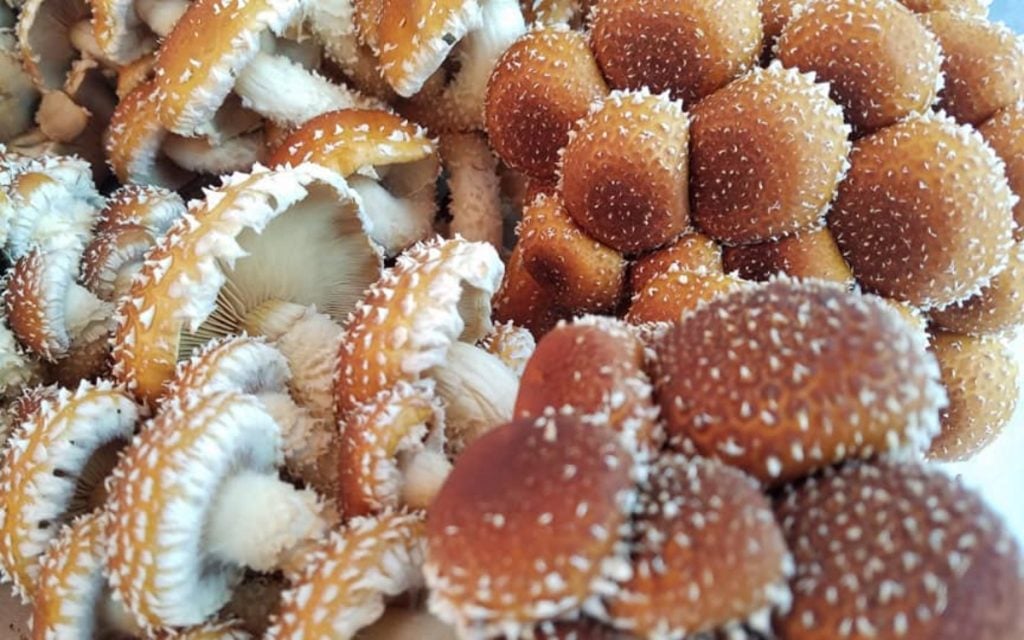
Can You Eat Chestnut Mushrooms?
Yes, you can eat chestnut mushrooms, and while they may be new to you, the Japanese have enjoyed them for their taste, texture and health benefits for centuries.
Below we provide some easy and tasty chestnut mushroom recipes for you to try.
What’s the Difference Between Chestnut Mushrooms and Normal Mushrooms?
Chestnut mushrooms are unique, as when cooked correctly, both the cap and stem maintain a lovely firm texture.
While normal mushrooms like white, brown, button or cremini mushrooms become soft when cooked and can even become limp and soggy if not cooked properly.
Chestnut mushrooms have long, crisp stems, much longer than cremini or button mushroom stems, and the entire mushroom, including the stem, is edible.
You can grow chestnut mushrooms on logs and indoors on hardwood sawdust fruiting blocks, unlike portabellas, creminis or button mushrooms which grow in composted manure.
Are Brown Mushrooms The Same as Chestnut Mushrooms?

No brown mushrooms are not the same as the Pholiota adiposa species of chestnut mushroom, and you can easily tell them apart by their very different stems.
But, mushroom cultivators sometimes market common brown or cremini mushrooms as chestnut mushrooms.
So if you come across chestnut mushrooms in a store that look very similar to common button mushrooms, they are probably Agaricus bisporus, the same family as brown or cremini mushrooms.
What Do Chestnut Mushrooms Taste Like?
Chestnut mushrooms taste similar to shiitake mushrooms but milder, with a distinct nutty umami flavor that gives them their name.
Their mild earthy flavor has a slightly peppery finish, and people often describe them as buttery and nutty.
But, it’s their crunchy texture, fabulous color and long edible stems that add new dimensions to mushroom dishes. They’re often the reason that people choose to cook with chestnut mushrooms.
Where Do Chestnut Mushrooms Grow?
You will often find wild chestnut mushrooms growing in clusters low down on dead or dying beech trunks, stumps and large fallen branches.
But, while commonly on beech, they can also be found on poplars, oaks and other broadleaf hardwoods.
Interestingly, chestnut mushrooms can grow on both living and dead trees as they’re both saprotrophic and parasitic, but they tend to grow better on dead and decaying wood.
They’re found in the wild in northern and central Europe and occasionally throughout Britain and Ireland during the fall, winter and early spring.
What Mushrooms Are Similar to Chestnut Mushrooms?
Here are several look-alike cluster-growing mushrooms that you may come across when foraging for chestnut mushrooms:
Shaggy Scalycap (Pholiota squarrosa)

The shaggy scalycap is common in North America, Canada and Europe, growing on a range of hardwoods and conifers. It’s usually paler with much larger caps and stem scales than the chestnut mushroom.
Depending on the source, the smell of the shaggy scalycap is said to be similar to garlic, radish, skunk or onion with a strong taste similar to radish.
Although reported as edible by some, it can cause poisoning if consumed with alcohol.
Alder Scalycap (Pholiota alnicola)
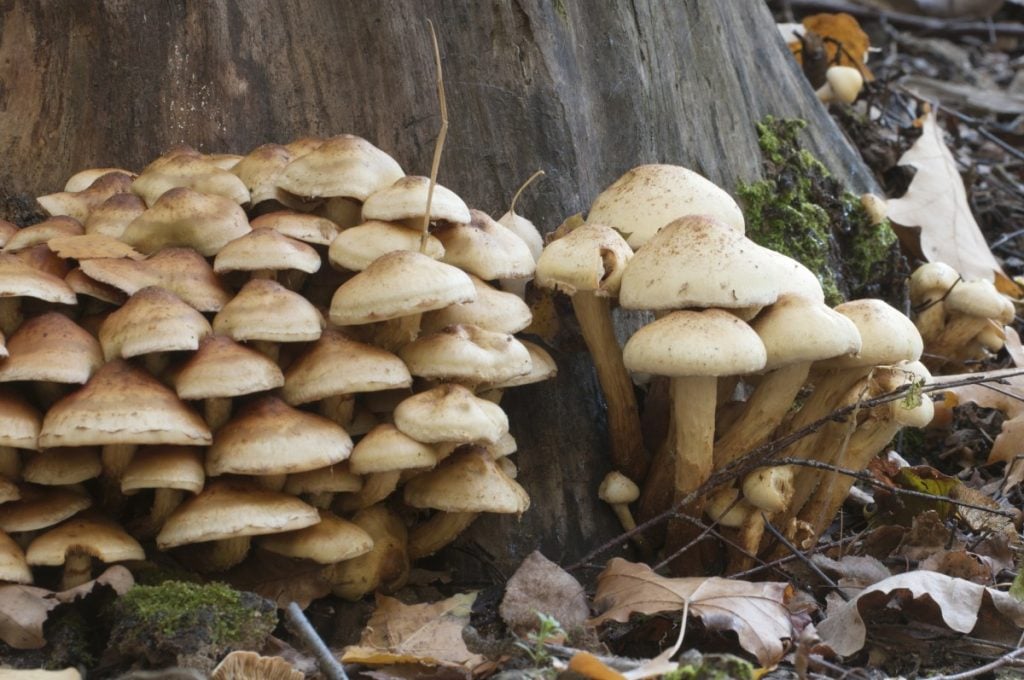
The alder scalycap is commonly found on dead and dying alder trunks but can also be found on other hardwoods and occasionally conifers.
It occurs throughout North America, northern and central Europe and Asia, and unlike chestnut mushrooms, the alder scalycap does not have scales on its cap.
Dark Honey Fungus (Armillaria mellea)

The dark honey fungus has scales and grows in clusters similar to chestnut mushrooms.
But dark honey fungus stems are darker and have a lot more scales than chestnut mushrooms which have a few scales towards the base of the stem.
Another difference is that dark honey fungi have white spores meaning their gills do not darken as they mature.
Sheathed Woodtuft (Kuehneromyces mutabilis)
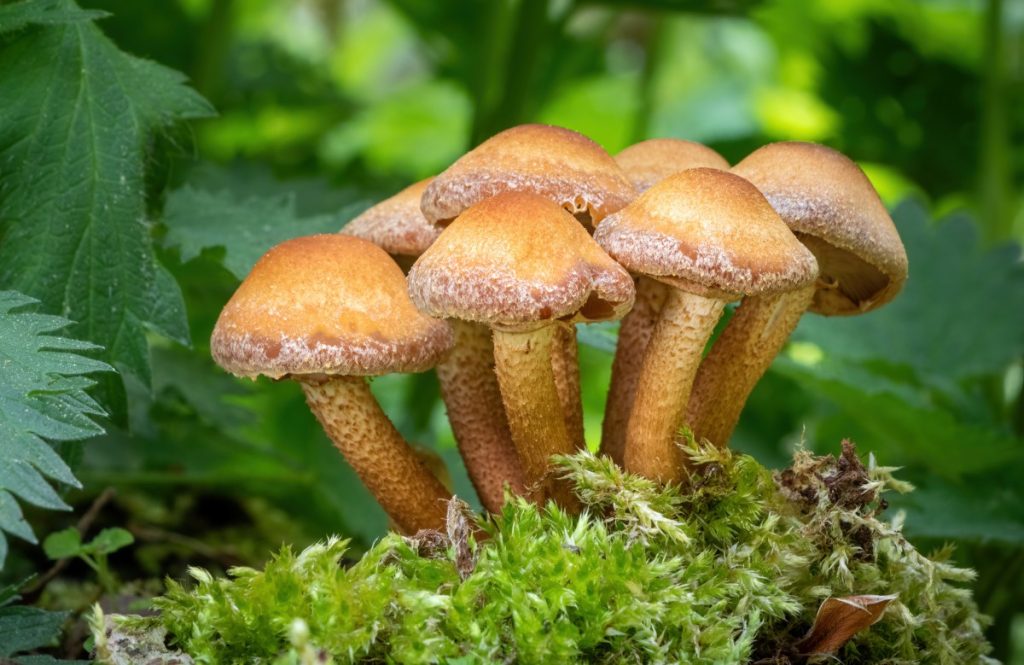
Also known as the brown stew fungus and two-toned Pholiota, this pretty edible fungus grows throughout Britain, Ireland, Europe, Asia, Australia and North America.
Sheathed Woodtuft mushrooms can look very similar to chestnut mushrooms, although the caps are usually two-toned and change color.
When wet, they’re cinnamon-orange but dry to a much lighter tan color.
The biggest difference is their stems, which have an obvious ring and a much darker color below the ring.
The Funeral Bell Mushroom (Galerina autumnalis)
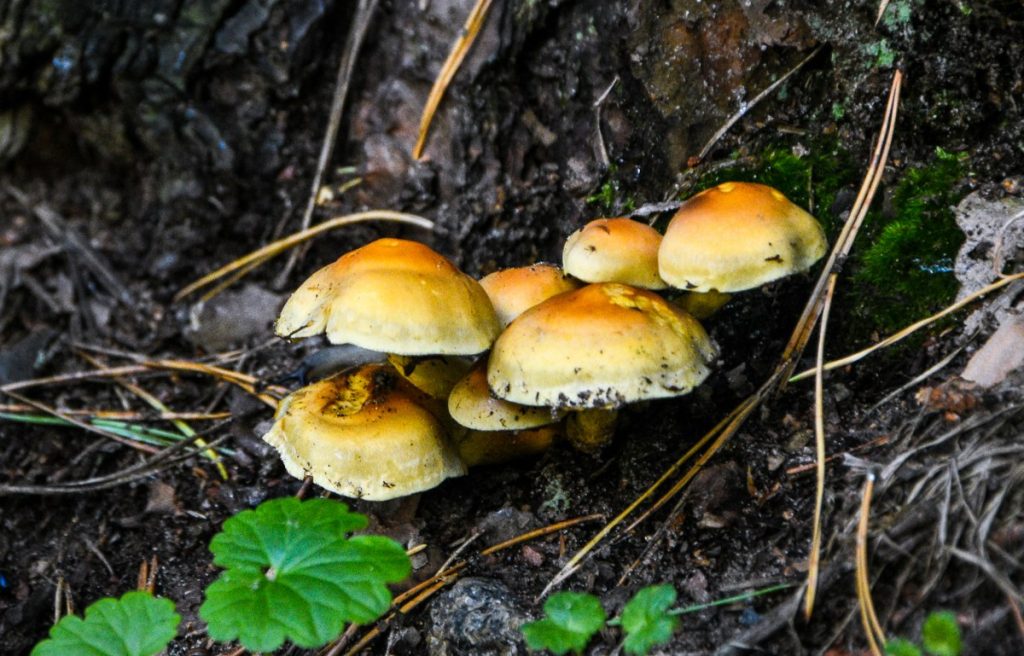
This mushroom is one look-alike that you need to steer clear of at all costs.
The name says it all, these mushrooms are deadly and contain the same toxins as the death cap mushroom (Amanita phalloides).
Like chestnut mushrooms, they grow in clusters and have sticky brown caps and gills that change from yellow to rust-brown, but a noticeable difference is that they do not have scales on their caps.
Health and Nutritional Benefits of Chestnut Mushrooms
Like most other edible mushrooms, chestnut mushrooms are packed full of essential amino acids, vitamins, minerals and proteins.
This Food Composition Database has a detailed breakdown of all the amino acids, minerals and vitamins found in a 100g serving of chestnut mushrooms known as Numerisugitake in Japan.
Chestnut mushrooms are not only a good source of protein and other nutrients, but they also have antimicrobial and anti-tumor properties and contain lectins that help prevent the spread of certain cancer cells.
They also contain anti-inflammatory and antioxidative compounds that help treat inflammation and boost the immune system.
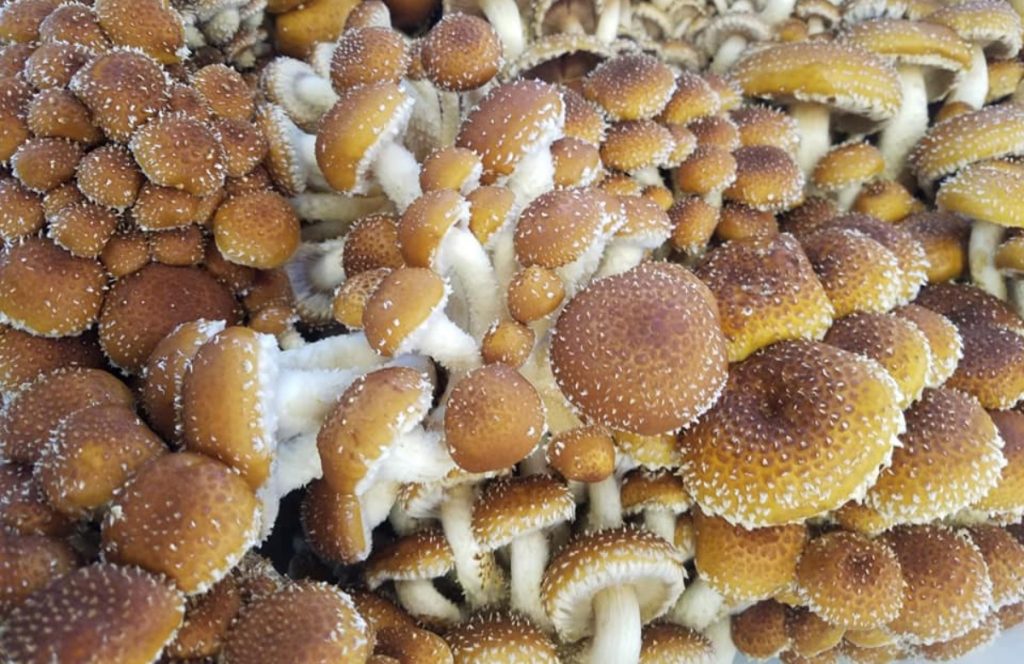
How to Grow Chestnut Mushrooms at Home
Currently, only a few mushroom growers cultivate chestnut mushrooms commercially, so the best way to get hold of fresh chestnut mushrooms is to grow your own.
The good news is that chestnut mushrooms are relatively easy to grow, and there are a few different methods you can use when growing chestnut mushrooms at home.
Although, they’re not as easy to grow as oyster mushrooms, which are one of the easiest mushrooms to grow at home.
Here are some of the ways you can grow chestnut mushrooms at home:

1. A Mushroom Growing Kit
The easiest way to grow chestnut mushrooms, especially if you are new to mushroom growing, is to purchase a chestnut mushroom growing kit online from a supplier near you.
The growing kit consists of a bag or fruiting block of hardwood substrate fully colonized by chestnut mushroom mycelium and ready to grow.
All you’ll need to do is cut the bag, place your kit on a table countertop or shelf with fruiting conditions and keep the opening moist.
Are you wondering what fruiting conditions are?
Fungi need specific environmental conditions, called fruiting conditions, to fruit and produce mushrooms.
When growing mushrooms at home, you need to replicate these conditions as closely as possible.
The ideal fruiting conditions for chestnut mushrooms are temperatures of 55-75 F (13 – 24 C) and humidity levels of 85-90 percent.
Normal to slightly cool room temperatures are fine for growing chestnut mushrooms, and unless you live somewhere with extreme temperatures, you’ll not need a temperature-controlled room.
Humidity, however, is extremely important, and without the necessary levels of moisture, baby mushroom pins will not form, and if they dry completely, they’ll stop growing.
To keep humidity levels high, spray the exposed substrate and young mushrooms two to three times a day with water.
If you live in a dry climate, you can use a loose-fitting plastic bag with plenty of holes to make a humidity tent to place over your growing kit.
You will still need to spray inside the bag once a day and ensure it has enough holes to allow adequate airflow.
Like other mushrooms, chestnut mushrooms also need light to grow, and indirect light is best.
Avoid places where there is direct sunlight.
If you can comfortably read a book in the area where you are planning to put your growing kit, then your chestnut mushrooms will get enough light to grow properly.
It can take anywhere from 12 to 28 days before you see baby chestnut mushroom pins forming, and five to ten days later, you’ll be able to harvest your first fresh chestnut mushrooms.
It is best to harvest chestnut mushrooms when they’re young before their caps start to flatten out.
To harvest chestnut mushrooms, gently twist and pull the entire cluster of mushrooms off the block, being careful not to take too much substrate with you.
You will be able to get another one or two flushes of chestnut mushrooms from your fruiting block, although they’ll be smaller than the first flush.
2. Indoors in Grow Bags
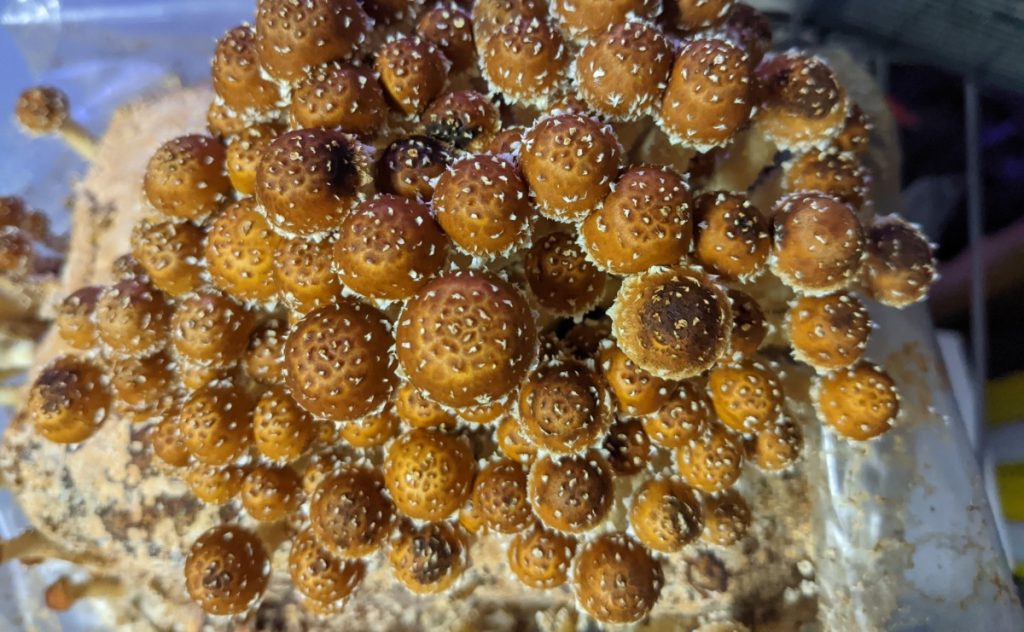
More experienced mushroom growers, or those who like a challenge, can order chestnut mushroom grain spawn, prepare substrate and make their own fruiting blocks.
If you choose this method of growing chestnut mushrooms, it will take a little longer to get your first harvest, as chestnut mushroom spawn takes four to six weeks to fully colonize a block of substrate.
To make fruiting blocks, you’ll need:
- substrate material,
- chestnut mushroom spawn
- mushroom growing bags or other containers
Chestnut mushrooms grow best on amended hardwood substrates, but like most other wood-loving mushrooms, you could try growing them on straw or even cardboard.
Although, your harvest will be smaller as cardboard does not provide as much food for the mushroom mycelium as hardwood substrates.
Our article on how to grow mushrooms in a bag has detailed step-by-step instructions to help you prepare, inoculate and incubate fruiting blocks.
When colonization is complete, cut a slit in the grow bag and place the block in fruiting conditions in the same way as you would a growing kit.
Outdoors on Logs
You can also grow chestnut mushrooms outdoors on stumps and logs using plug, grain or sawdust spawn, and while they’ll grow on a variety of hardwood logs, they grow best on maple or oak logs.
When growing mushrooms on logs, you have to wait much longer, around a year, for your first flush of mushrooms.
But, you’ll then have an ongoing supply of fresh chestnut mushrooms for several years.
Our ultimate guide to growing mushrooms on logs has more information and step-by-step instructions to help you grow chestnut mushrooms on logs.
How to Clean Chestnut Mushrooms
If you harvest chestnut mushrooms grown indoors in a grow bag, there’s often no need to wash them at all.
Simply cut off the very bottom of the stems, which can sometimes be a bit tough, and your chestnut mushrooms are ready to cook.
But, if you have collected your chestnut mushrooms in the wild or harvested them from your logs, they may need a quick rinse to get rid of any insects, dirt and debris.
The best way to clean mushrooms is to quickly rinse them under running water and pat them dry with a paper towel.
Remember to wash your hands after handling chestnut mushrooms, as they can temporarily stain your hands orange.
If you want to learn more about cleaning mushrooms, our article, “How to Clean Mushrooms: A Step by Step Guide,” has more information and step-by-step instructions.
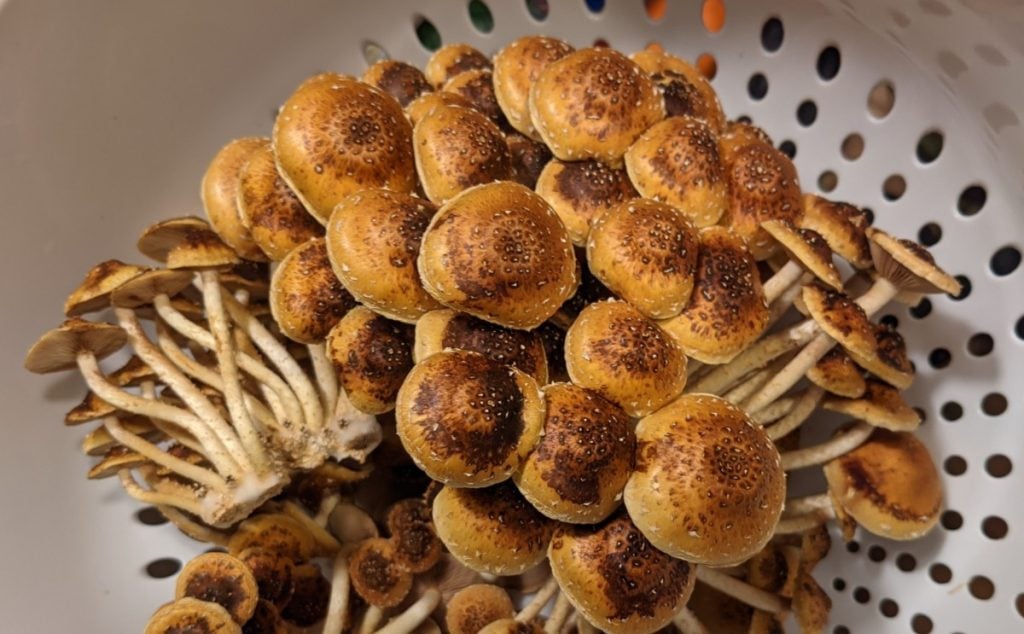
How to Store Chestnut Mushrooms
Like other mushrooms, chestnut mushrooms are best stored in the fridge for up to four days if you do not plan on using them immediately.
They will last longest if stored correctly in a breathable bag or container on a shelf in the fridge and not in the bottom compartment.
Do not slice or rinse your chestnut mushrooms before storing them in the fridge, as this often makes them go bad faster.
Rather rinse and trim them just before you plan on cooking them.
But if you want to preserve your chestnut mushrooms for use at a much later date, then either drying or freezing them may be a good solution.
How to Cook Chestnut Mushrooms
You can use chestnut mushrooms the same way as you would use shiitake mushrooms, and like shiitakes, they’re best when sauteed as you can experience their true flavor and texture.
Our article on how to sautee mushrooms has lots of tips to help you get perfectly sauteed mushrooms every time.
Chestnut mushrooms go well with onion, garlic and shallots and you can serve them with meat, on salads and in soups, cream sauces, casseroles and stir-fries.
When cooking chestnut mushrooms, you use both the stems and caps, and the result is a delicious dish with two different mushroom textures.
While the entire mushroom retains its firmness, the caps have a silky texture when cooked, and the stems are crunchy, similar to lightly cooked celery or asparagus.
What Are Chestnut Mushrooms Good For?
The fact that chestnut mushrooms retain their shape and texture and don’t shrink as much as many other mushrooms during cooking makes them versatile and perfect for dishes that require longer cooking times like soups and stews.
Their mild earthy flavor and unique textures create a nice variation to most dishes, work well in creamy sauces and are exceptional in miso and other brothy soups.
Chestnut Mushrooms Substitute
If you can’t get hold of fresh chestnut mushrooms, you can substitute other wild mushrooms like shiitake or shimeji.
Shiitake mushrooms have a similar but slightly stronger flavor but do not have crisp stems like chestnut mushrooms.
And while shimeji have long thin crispy stems, they have milder flavors and lack the lovely colors of chestnut mushrooms.
Chestnut Mushroom Recipes
Looking for some tasty ways to use your chestnut mushrooms? Here are some recipes that make the most of the chestnut mushrooms delicious flavors and textures:
1. Chestnut Mushroom Omelet
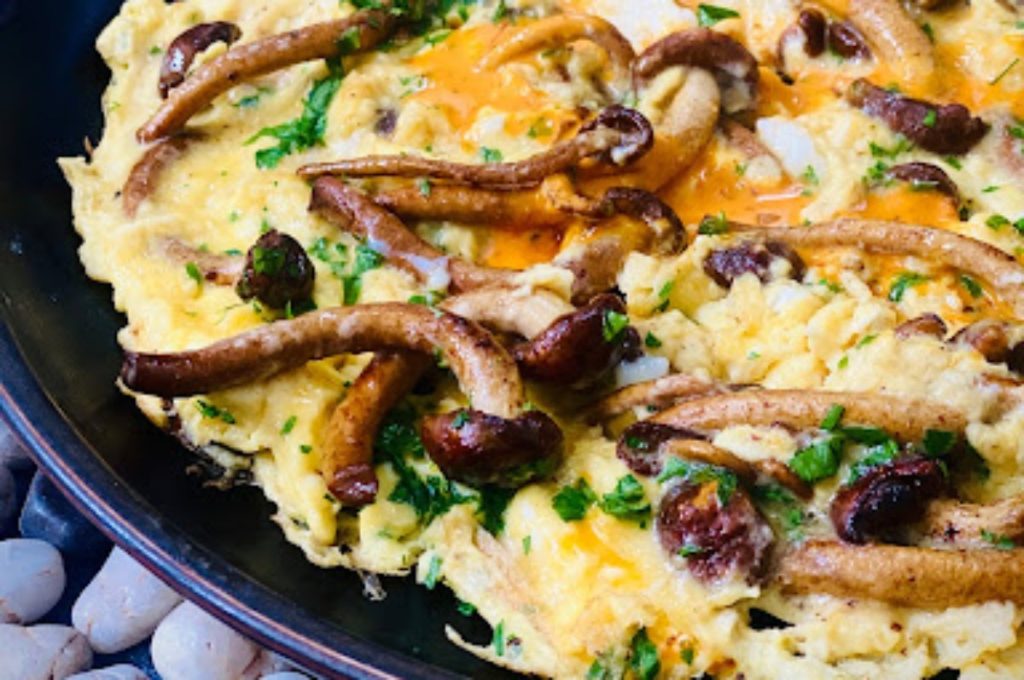
The nutty flavor and crunchy texture of chestnut mushrooms are great for omelets. This recipe from Steamy Kitchen makes a light and fluffy omelet that is healthy and delicious.
Ingredients
- 3 eggs
- 1½ tbsp creme fraiche (you can substitute sour cream if you don’t have creme fraiche)
- 4 oz (113 g) chestnut mushrooms cleaned and trimmed
- 2 tbsp water
- 1½ tbsp butter
- Salt and freshly ground black pepper
- 2 tbsp fresh parsley minced
- ¼ cup shredded cheese
- Hot sauce (optional)
Instructions
- Combine the eggs and creme fraiche or sour cream in a bowl and beat.
- Heat a heavy non-stick skillet over medium-high heat. When hot, add the mushrooms and water. Cook the mushrooms in the water for 1-2 minutes, until just starting to wilt but not completely softened. Do not overcook the mushrooms.
- Add in the butter, and saute the mushrooms until just tender.
- Turn the heat down to medium and add the egg and creme fraiche mixture. Use a spatula to gently scramble the eggs. The eggs should cook slowly to retain their silky, light texture. Cook until just set.
- Sprinkle with shredded cheese, season with salt, pepper and fresh parsley and add hot sauce, if desired.
2. Chestnut Mushroom Bourguignon
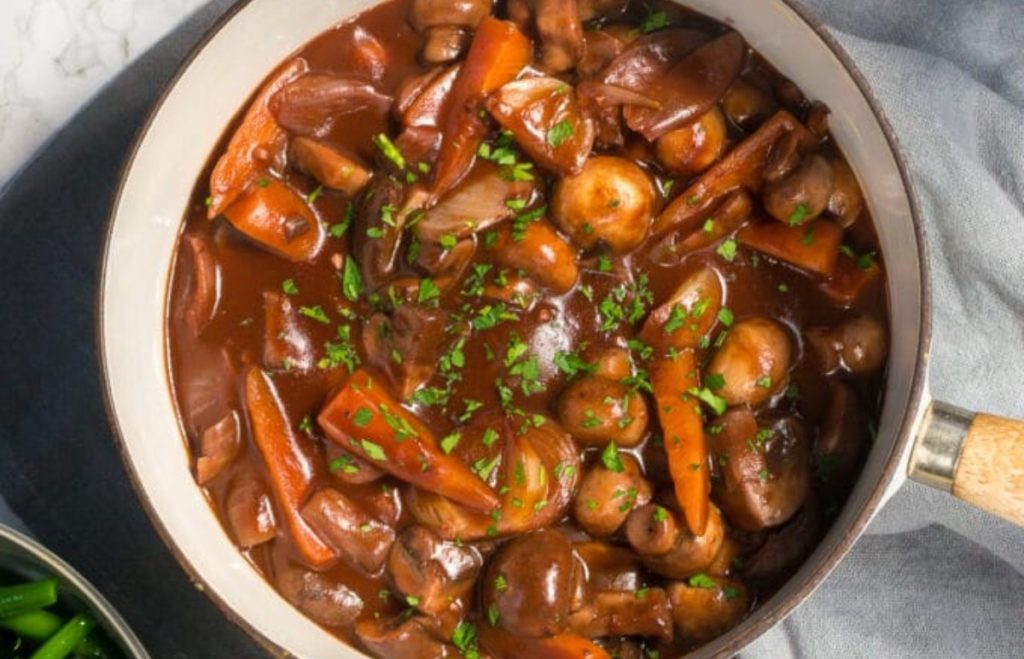
This recipe from Kate Ford at The Veg Space is quick and easy and perfect for cold winter nights.
It’s perfect with mashed potato and green beans, and the rich red wine sauce and different mushroom textures will impress dinner guests.
Ingredients
- 2 tbsp olive oil
- 4-5 small shallots peeled and cut into halves or quarters or 1 small onion
- 10 baby carrots trimmed and halved lengthways (or quartered if they’re large)
- 1 tsp ready-chopped garlic or garlic purée
- 9 oz (250 g) chestnut mushrooms cleaned and cut into quarters
- 3.5 oz (100 g) button mushrooms cleaned
- 1½ tbsp plain flour
- 6.8 oz (200 ml) red wine check it is vegan
- 5 oz (150 ml) boiling water
- 1 tsp vegetable stock powder
- 1 tbsp tomato purée
- handful fresh parsley roughly chopped
Instructions
- Heat the oil in a large frying pan or casserole over high heat, then add the shallots to the pan with the garlic and allow to cook for around 30 seconds until fragrant.
- Add the carrots and cook for a few minutes until slightly softened.
- Add the chestnut mushrooms and button mushrooms to the pan and cook for 2 minutes.
- Stir the flour through the mushrooms, then add the red wine and bring to a vigorous boil for a minute before adding the water, stock powder and tomato purée.
- Cook over medium to high heat until a thick, glossy sauce has formed and the mushrooms are just cooked through but not too soft.
- Season with salt and black pepper
- Stir two-thirds of the parsley through the bourguignon.
- Serve garnished with the remaining parsley.
3. Lentil, Chestnut Mushroom and Amaranth Soup

The chestnut mushrooms’ unique textures and the fact that they retain their crispness, even when cooked, make them ideal for use in soups.
This healthy and warming winter soup recipe from Valerie at Very Vegan Val uses carrots, onions and garlic to build a strong base for the lentils and amaranth, with strong, nutty mushroom flavors and colorful and vibrant swiss chard for added impact.
Ingredients
1 Tbsp olive oil
2-3 carrots, diced
1 onion, diced
2 cloves of garlic, minced
1 cup of chestnut mushrooms (or shiitake, bunapi, crimini), cleaned and with the ends of the stems cut off
8-10 cups of vegetable broth/water, depending on how much broth you like
½ cup of white wine
2 bay leaves
1 cup small green lentils
½ cup amaranth grain
4-5 kale, chard or other hearty green leaves chopped into bite-sized pieces (about 2 cups chopped)
Salt and pepper, to taste
Instructions
- Heat the oil in a large pot. Then add the carrots, onions, garlic and mushrooms and cook for 2-3 minutes.
- Add the vegetable broth, wine, bay leaves and lentils. Bring to a boil, then reduce heat, cover and simmer for 20 minutes.
- Add the amaranth and greens. Cover again and allow to cook for an additional 20 minutes.
- Check the lentils. If they’re soft enough, remove from the heat and season to taste with salt and pepper. If not, allow them to cook for another 5-10 minutes until they’re soft.
- Serve and enjoy.
For more delicious mushroom recipes to inspire you, we’ve put together a list of 25 of the best vegan mushroom recipes, 30 of our favorite tried and tested mushroom recipe ideas and 5 Easy and delicious Keto mushroom recipes.
Where to Buy Chestnut Mushrooms
Although chestnut mushrooms are relatively unknown outside of Asia, they’re growing in popularity, and you may be able to buy them at your local farmers’ market.
You can also often buy chestnut mushrooms from local mushroom growers who grow other species of wood-loving mushrooms.
Chestnut mushrooms enjoy the same substrates and growing conditions as oyster mushrooms, shiitake and lion’s mane mushrooms.
So if your local mushroom grower can get chestnut mushroom spawn, they’ll be able to provide you with fresh chestnut mushrooms.
Another place to find and buy dried and fresh chestnut mushrooms is online, but you’ll have to order from a mushroom farm nearby if you want fresh mushrooms as they cannot travel long distances during delivery.
Final Thoughts
If you enjoy trying new and unique types of mushrooms, chestnut mushrooms are a great option.
They’re beautiful to look at, have a lovely nutty flavor, add interesting textures to any dish and provide a range of health benefits.
One of the best ways to get fresh chestnut mushrooms is to grow your own, and an added benefit is that you remove the risk of accidentally picking dangerous look-alikes in the wild.
To learn more about growing mushrooms at home and where to start, visit our Mushroom Growing Hub.
